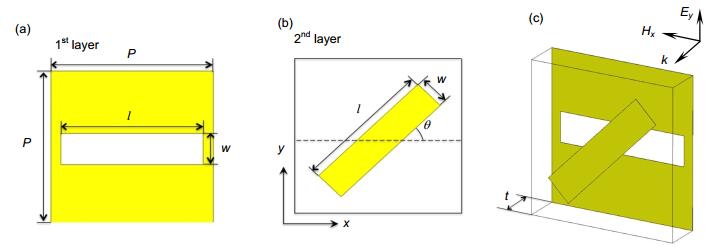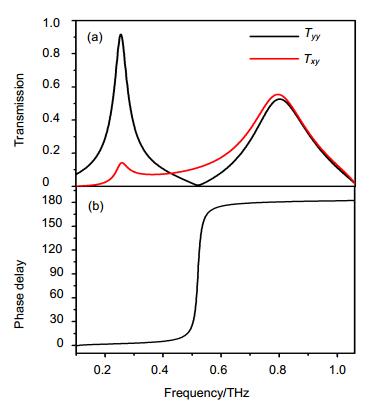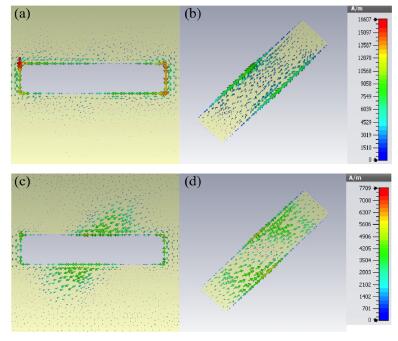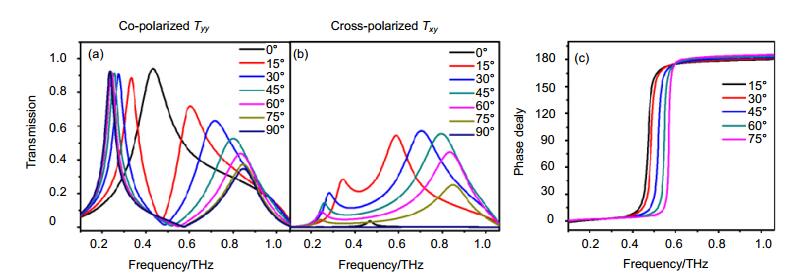| Citation: | Wang Dacheng, Gong Yandong, Hong Minghui. Complementary bilayer metasurfaces for enhanced terahertz wave amplitude and phase manipulation[J]. Opto-Electronic Engineering, 2017, 44(1): 77-81. doi: 10.3969/j.issn.1003-501X.2017.01.007 |
Complementary bilayer metasurfaces for enhanced terahertz wave amplitude and phase manipulation
-
Abstract
Manipulation of terahertz wave by metasurfaces has shown tremendous potential in developing compact and functional terahertz optical devices. Here, we propose complementary bilayer metasurfaces for enhanced terahertz wave amplitude and phase manipulation. The metasurfaces are composed of one layer of metal cut-wire arrays and one layer of their complementary aperture arrays separated by a dielectric spacer. Through the near-field coupling between transverse magnetic resonances in the metal apertures and electric resonances in the metal cut-wires, the structures can manipulate the cross polarization conversion and phase dispersion of terahertz wave. Particularly, the designed metasurfaces demonstrate a phase delay of 180° between two orthogonal axes with the same transmission amplitude between 0.70 and 1.0 THz, enabling a 45° broadband polarization conversion. When the metal cut-wires are rotated with respect to the apertures or the thickness of the dielectric spacer is changed, the amplitude and phase dispersion of the transmitted terahertz wave can be tuned. Such complementary coupled bilayer metasurfaces offer a new method to control the amplitude and phase dispersion of terahertz wave and promise great potential for applications in terahertz meta-devices.
-
Keywords:
- metasurfaces /
- terahertz /
- polarization /
- wave manipulation
-

-
References
[1] Tonouchi M. Cutting-edge terahertz technology[J]. Nature Photonics, 2007, 1(2): 97-105. doi: 10.1038/nphoton.2007.3 [2] Choi Y, Choi J W, Cioffi J M. A geometric-statistic channel model for THz indoor communications[J]. Journal of Infrared, Millimeter, and Terahertz Waves, 2013, 34(7/8): 456-467. [3] Federici J F, Schulkin B, Huang Feng, et al. THz imaging and sensing for security applications-explosives, weapons and drugs[J]. Semiconductor Science and Technology, 2005, 20(7): S266-S280. doi: 10.1088/0268-1242/20/7/018 [4] Hasebe T, Kawabe S, Matsui H, et al. Metallic mesh-based terahertz biosensing of single- and double-stranded DNA[J]. Journal of Applied Physics, 2012, 112(9): 094702. doi: 10.1063/1.4761966 [5] Orlando A R, Gallerano G P. Terahertz radiation effects and biological applications[J]. Journal of Infrared, Millimeter, and Terahertz Waves, 2009, 30(12): 1308-1318. [6] Wojdyla A, Gallot G. Attenuated internal reflection terahertz imaging[J]. Optics Letters, 2013, 38(2): 112-114. doi: 10.1364/OL.38.000112 [7] Chen H T, Padilla W J, Cich M J, et al. A metamaterial solid-state terahertz phase modulator[J]. Nature Photonics, 2009, 3(3): 148-151. doi: 10.1038/nphoton.2009.3 [8] Chen Houtong, Padilla W J, Zide J M O, et al. Active terahertz metamaterial devices[J]. Nature, 2006, 444(7119): 597-600. doi: 10.1038/nature05343 [9] Masson J B, Gallot G. Terahertz achromatic quarter-wave plate[J]. Optics Letters, 2006, 31(2): 265-267. doi: 10.1364/OL.31.000265 [10] Chen Zaichun, Gong Yandong, Dong Hui, et al. Terahertz achromatic quarter wave plate: design, fabrication, and characterization[J]. Optics Communications, 2014, 311: 1-5. [11] Yu Nanfang, Capasso F. Flat optics with designer metasurfaces[J]. Nature Materials, 2014, 13(2): 139-150. doi: 10.1038/nmat3839 [12] Zheng Guoxing, Mühlenbernd H, Kenney M, et al. Metasurface holograms reaching 80% efficiency[J]. Nature Nanotechnology, 2015, 10(4): 308-312. doi: 10.1038/nnano.2015.2 [13] Kildishev A V, Boltasseva A, Shalaev V M. Planar photonics with metasurfaces[J]. Science, 2013, 339(6125): 1232009. doi: 10.1126/science.1232009 [14] Zheludev N I, Kivshar Y S. From metamaterials to metadevices[J]. Nature Materials, 2012, 11(11): 917-924. doi: 10.1038/nmat3431 [15] Meinzer N, Barnes W L, Hooper I R. Plasmonic meta-atoms and metasurfaces[J]. Nature Photonics, 2014, 8(12): 889-898. doi: 10.1038/nphoton.2014.247 [16] Lin Dianmin, Fan Pengyu, Hasman E, et al. Dielectric gradient metasurface optical elements[J]. Science, 2014, 345(6194): 298-302. doi: 10.1126/science.1253213 [17] Luo Xiangang. Principles of electromagnetic waves in metasurfaces[J]. Science China Physics, Mechanics & Astronomy, 2015, 58(9): 594201. [18] Pu Mingbo, Li Xiong, Ma Xiaoliang, et al. Catenary optics for achromatic generation of perfect optical angular momentum[J]. Science Advances, 2015, 1(9): e1500396. doi: 10.1126/sciadv.1500396 [19] Ma Xiaoliang, Pu Mingbo, Li Xiong, et al. A planar chiral meta- surface for optical vortex generation and focusing[J]. Scientific Reports, 2015, 5: 10365. doi: 10.1038/srep10365 [20] Li Xiong, Pu Mingbo, Wang Yanqin, et al. Dynamic control of the extraordinary optical scattering in semicontinuous 2D meta materials[J]. Advanced Optical Materials, 2016, 4(5): 659-663. doi: 10.1002/adom.v4.5 [21] Cong Longqing, Cao Wei, Zhang Xueqian, et al. A perfect metamaterial polarization rotator[J]. Applied Physics Letters, 2013, 103(17): 171107. doi: 10.1063/1.4826536 [22] Gao Lihua, Cheng Qiang, Yang Jing, et al. Broadband diffusion of terahertz waves by multi-bit coding metasurfaces[J]. Light: Science & Applications, 2015, 4(9): e324. [23] Wang Dacheng, Zhang Lingchao, Gu Yinghong, et al. Switchable ultrathin quarter-wave plate in terahertz using active phase- change metasurface[J]. Scientific Reports, 2015, 5: 15020. doi: 10.1038/srep15020 [24] Wang Dacheng, Qiu Chengwei, Hong Minghui. Coupling effect of spiral-shaped terahertz metamaterials for tunable electromagnetic response[J]. Applied Physics A, 2014, 115(1): 25-29. [25] Jia Shengli, Wan Xiang, Bao Di, et al. Independent controls of orthogonally polarized transmitted waves using a Huygens metasurface[J]. Laser & Photonics Review, 2015, 9(5): 545- 553. [26] Wang Dacheng, Gu Yinghong, Gong Yandong, et al. An ultrathin terahertz quarter-wave plate using planar babinet-inverted metasurface[J]. Optics Express, 2015, 23(9): 11114-11122. doi: 10.1364/OE.23.011114 [27] Zalkovskij M, Malureanu R, Kremers C, et al. Optically active Babinet planar metamaterial film for terahertz polarization manipulation[J]. Laser & Photonics Review, 2013, 7(5): 810-817. [28] Qin Fei, Ding Lu, Zhang Lei, et al. Hybrid bilayer plasmonic metasurface efficiently manipulates visible light[J]. Science Advance, 2016, 2(1): e1501168. [29] Grady N K, Heyes J E, Chowdhury D R, et al. Terahertz metamaterials for linear polarization conversion and anomalous refraction[J]. Science, 2013, 340(6138): 1304-1307. doi: 10.1126/science.1235399 [30] Chen W C, Landy N I, Kempa K, et al. A subwavelength extraordinary-optical-transmission channel in babinet meta materials[J]. Advanced Optical Materials, 2013, 1(3): 221-226. doi: 10.1002/adom.201200016 [31] Cong Longqing, Xu Ningning, Gu Jianqiang, et al. Highly flexible broadband terahertz metamaterial quarter-wave plate[J]. Laser & Photonics Review, 2014, 8(4): 626-632. [32] Grbovic D, Alves F, Kearney B, et al. Metal-organic hybrid resonant terahertz absorbers with SU-8 photoresist dielectric layer[J]. Journal of Micro/Nanolithography, MEMS and MOEMS, 2013, 12(4): 041204. doi: 10.1117/1.JMM.12.4.041204 -
Overview

Abstract: Manipulation of terahertz wave by metasurfaces has shown tremendous potentials in developing compact and functional terahertz optical devices. However, there are still some obstacles that limit the practical applications of these meta-devices, such as low working efficiency and narrow operating bandwidth. Here, we propose complementary bilayer metasurfaces for enhanced terahertz wave amplitude and phase manipulation. The metasurfaces are composed of one layer of metal cut-wire arrays and one layer of their complementary aperture arrays separated by a dielectric spacer. The complementary apertures in the metasurfaces give rise to extraordinary optical transmission. When metal cut-wires are positioned near the apertures, the structures can manipulate the cross polarization conversion and phase dispersion of terahertz wave through the near-field coupling between transverse magnetic resonances in the metal apertures and electric resonances in the metal cut-wires. Particularly, when the thickness of the dielectric spacer is 8 μm and the rotation angle between the cut-wire and the aperture is 45°, the metasurfaces demonstrate a phase delay of 180° between two orthogonal axes with the same transmission amplitude between 0.70 and 1.0 THz, enabling a 45° broadband polarization conversion. A transmission peak at 0.25 THz can be observed for the co-polarized light. This peak corresponds to the extraordinary optical transmission effect in the metal apertures. A small peak for cross-polarized light at 0.25 THz corresponds to a weak excitation of the dipole resonance in the metal cut-wires. Numerical simulated surface current distributions in these two layers show opposite directions, indicating that a magnetic dipole can be formed within the circulating currents between the aperture and the cut-wire. The strong coupling between these two layers leads to a transmission peak at 0.80 THz. Furthermore, the phase dispersion of the transmitted light is modified by this coupling effect and a phase delay of 180° between 0.70 and 1.0 THz is achieved. When the metal cut-wires are rotated with respect to the apertures, the phase delays maintain 180° in a broadband with a small shift of the frequency. When thickness of the dielectric spacer increases, the resonance frequency of the metal aperture decreases, while the frequency of the coupled magnetic dipole resonance increases. When the thickness of the dielectric spacer is smaller, a larger transmission peak for the cross-polarized light is achieved. This indicates that a thinner dielectric spacer would provide a stronger coupling between the aperture and the cut-wire. Meanwhile, with a thinner dielectric spacer, a broader bandwidth for the phase delay of 180° can be realized. Such complementary coupled bilayer metasurfaces offer a new method to control the amplitude and phase dispersion of terahertz wave and promise great potential for applications in terahertz meta-devices.
-
Access History

-
Figure 1.
Schematic of the designed unit cell of (a) the first layer, (b) the second layer and (c) the complementary coupled bilayer metasurfaces.
-
Figure 2.
Transmission spectra (a) for the co-polarized and the cross-polarized light with (b) the phase delay.
-
Figure 3.
Surface current distributions of (a) the metal aperture and (b) metal cut-wire at 0.25 THz. Surface current distributions of (c) the metal aperture and (d) the metal cut-wire at 0.80 THz.
-
Figure 4.
Transmission spectra for (a) the co-polarized and (b) cross-polarized light when the rotation angle θ changes from 0° to 15°, 30°, 45°, 60°, 75° and 90°. (c) Phase delay between the co-polarized and cross-polarized light.
-
Figure 5.
Transmission spectra for (a) the co-polarized and (b) cross-polarized light when the thickness of the dielectric spacer varies from 1 to 2, 4, 8, 15, 20 and 30 μm. (c) Phase delay between the co-polarized and cross-polarized light.

 E-mail Alert
E-mail Alert RSS
RSS



 DownLoad:
DownLoad:






